
views
- Dig out the sod and level the dirt with a shovel or rake.
- Lay the pool's bottom rails and sink square pavers underneath them. Fill in the gaps with sand and tamp the sand down flat.
- Alternatively, spread sand over the area and lay a wooden beam across. Insert a metal rod through the beam’s center and tamp down the sand.
Installing Paver Plates
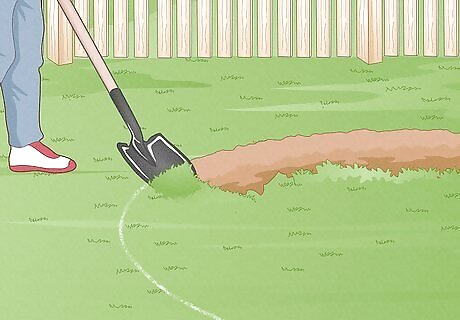
Dig out the sod to clear the area. Use a shovel to remove all the grass in the area where the pool will be installed. Also remove rocks and other debris. If there were plants in the area, dig down to get to any roots hidden under the soil. A sod cutter, rented from a hardware store, can help you clear large areas of grass with ease. Applying a grass and weed killer here is also useful. Removing all the plants now ensures that they won't grow back later and damage the pool.
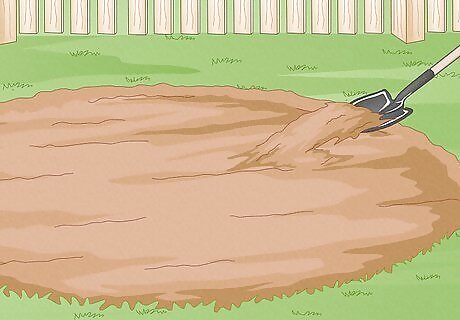
Move the dirt around until the area is flat. Hold a level against the ground. If the level doesn't lay flat, the soil needs to be adjusted. Dig out any high spots and fill holes with a shovel, then smooth out the soil by raking. No spot should be more than 2 in (5.1 cm) higher or lower than the rest of the area. Always be mindful when attempting to add material to level out low spots that the weight of the pool will compact the soil more than you can. Ideally you always want to dig down to level the ground, not just rely on adding soil to make things level.
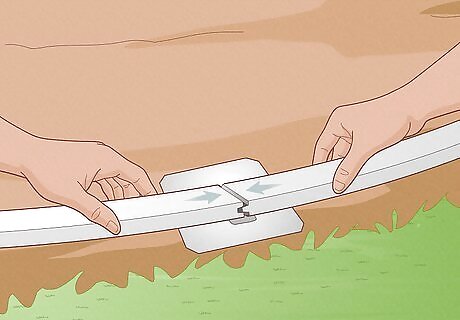
Lay and connect the pool’s bottom rails. Place the rails on the ground over the soil you leveled. Arrange them into a circle and push the ends together. Fasten the rails together according to the instructions in your owner’s manual. To ensure that the rails are spaced properly, use a tape measure to gauge the diameter of the circle. The rails should be the same distance apart on all sides.
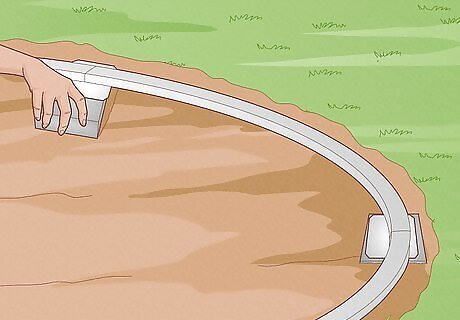
Sink square pavers under the connected rails. Get a few 6 in × 6 in (15 cm × 15 cm) square paver plates from the home improvement store if they’re not included with your pool. Place a plate wherever 2 rails connect. Dig under these connection points and place the plates so only the top shows above the soil. Use the level to ensure each plate is level and even with each other. Typically you will need to slide the rails into the grooves on the plates. Otherwise, leave the rails on top of the plates. Patio stones or blocks may be used in place of pavers.
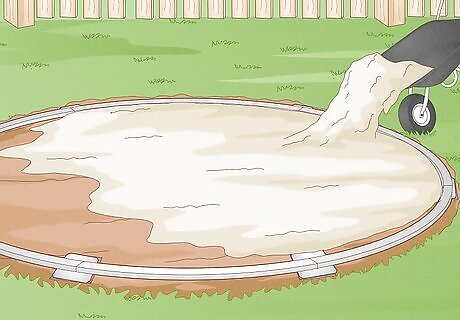
Fill the inside of the ring with sand. Start with 2 or 3 of bags of debris-free masonry sand from the home improvement store. Dump it into the circle made by the pool rails. Removing one of the pool rails may help make this easier. Add more sand as needed until you’ve got a uniform layer about 2 in (5.1 cm) high. Use a shovel or rake to move the sand around inside the circle. You want the sand to be distributed as evenly as possible under the pool’s bottom.
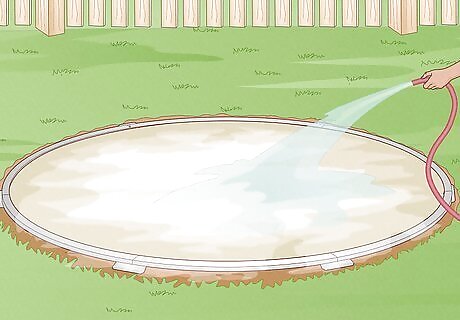
Wet the sand with a hose. Hook up a garden hose and soak the sand. Make sure all the sand gets wet so it solidifies. Keep spraying water until it begins to run off to the soil outside the circle. You will most likely need to do this again after tamping down the sand.
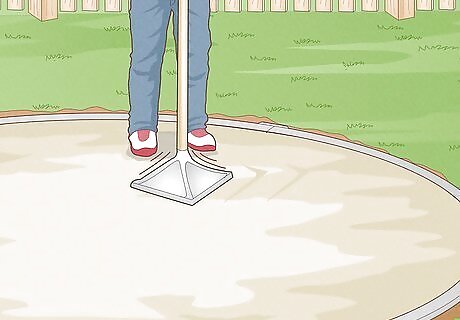
Tamp down the sand to make it compact. Start on the ring’s outside edges. Using a tamper from the hardware store or a heavy wooden block, press down on the sand. Work towards the middle to compact the sand as much as possible. When you no longer leave footprints in it, you can begin installing the pool. Check the sand’s consistency by walking on it. If you leave footprints, water and tamp it down again.
Using a Wooden Beam
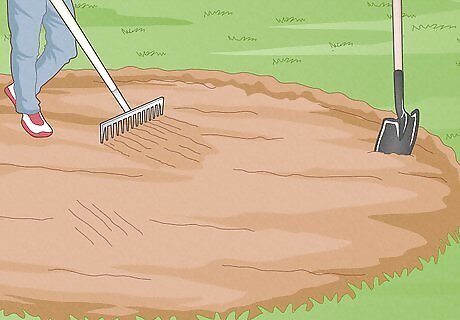
Shovel and rake the soil to get it level. Place a level against the soil in several spots across the circle. Shovel or rake the soil if necessary to ensure each area has a difference of no more than 2 in (5.1 cm). Instead of using a level, you can use string. Place stakes around the area’s border and connect them with strings lowered onto the soil. The spots that don’t reach the string are lower than the ones that do.

Spread sand over the leveled area. Start with 2 or 3 bags of sand and get more as needed. Concrete sand tends to hold up best, but yellow or white sand are also safe to use. Rake the sand to distribute it evenly. Shovel in more sand as needed to level the area. More sand is needed to to level out lower areas, so dump more of the sand there.
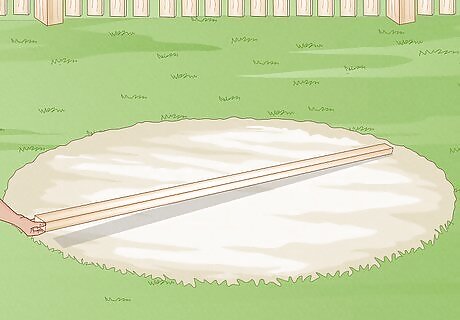
Lay a wooden beam across the sand. Pick up a 2 in × 4 in (5.1 cm × 10.2 cm) piece of wood from the store. It needs to span all the way across the area you’re leveling. If 1 board is too short, get 2 or more boards and fasten them together using small brace pieces and deck screws. For instance, if your pool is 15 ft (4.6 m) wide, connect 2 8 ft (2.4 m) boards.
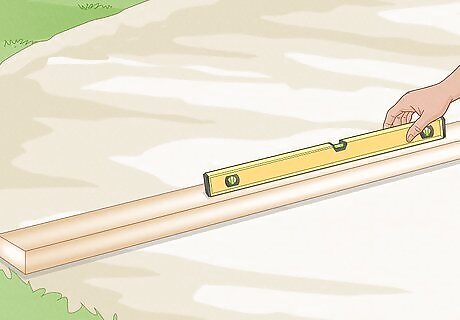
Place a level on top of the beam. Set the level on top of the board and fasten it in place with masking tape. This makes it easy to use as a guide while moving the beam. If the level and board appear even with the ground, you’ll know that the ground is flat enough for the pool.

Insert a metal rod through the beam’s center. First, drill a ⁄8 in (9.5 mm) hole all the way through the board. You can use a tape measure to find the center point. Insert a ⁄8 in (0.95 cm) rod from the home improvement store into the hole, then hammer it into the ground.
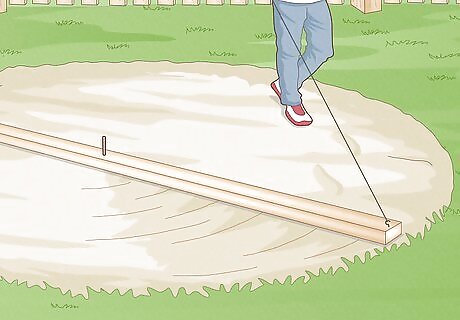
Pull 1 end of the board toward you to rotate it. Step into the circle and rotate the board by pulling 1 end toward you as you walk backwards. It will spin in place because of the metal rod. Keep an eye on the level to note when the ground appears uneven, and use the board to even out the sand. Your shoes will leave divots in the sand. These will fill in as you rotate the board. When you’re done rotating it, step out of the circle and shovel sand into the remaining divots.
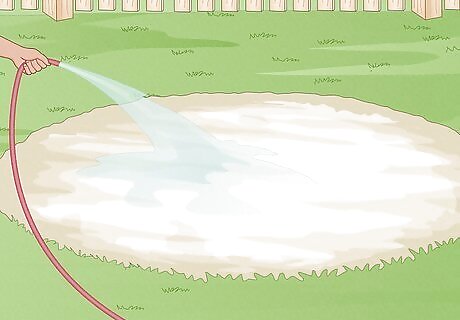
Compact the sand by spraying it with a hose. Thoroughly wet the sand with water to compact and level it. The entire circle should be soaked so you can tamp the sand. If you'd like to rely on rain to compact the sand, wait until you've gotten about ⁄2 in (1.3 cm) of rain, which should be enough to completely soak the sand.
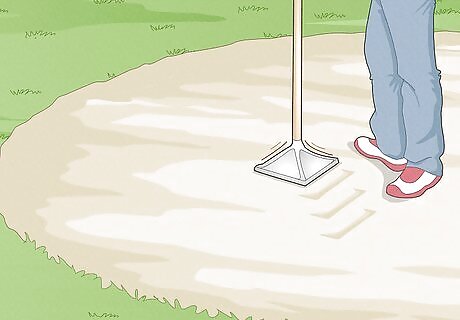
Tamp down the sand until it doesn’t leave footprints. Get a tamper from the home improvement store or create one by weighing down a wood block with a heavy chain. Start on the outside edges of the circle and work inwards. Make sure you use the tamper tool everywhere to compact the sand. Walk on the sand to test it, and when you don’t leave footprints, this area is ready for construction. The sand may need to be soaked and tamped down multiple times to be completely hardened.




















Comments
0 comment